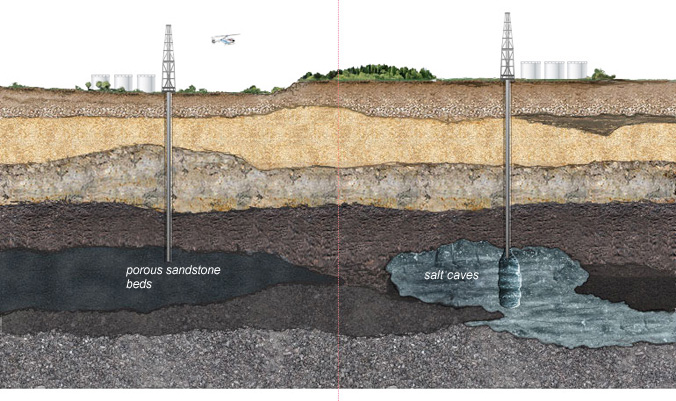Any product has to be stored. Gas is not an exception. The underground gas storage industry is almost 100 years old.
Fluctuations and peaks
UGS (underground gas storage) facilities largely contribute to the reliability of gas supplies to consumers. They level off daily gas consumption fluctuations and meet the peak demand in winter. UGS facilities are of particular importance in Russia with its cold climate and huge distances between resources and end users. Russia has the unique Unified Gas Supply System (UGSS), with the UGS system being the integral part of it. Underground storage facilities secure natural gas supplies to consumers regardless of a season, temperature, or force-majeure.

In winter, 25 operated storage facilities provide up to one fourth of the daily gas resources of the Russian UGSS, which is comparable to the total production at Yamburgskoye, Medvezhye, and Yubileynoye fields.
Provident nature
Gas fills much greater volumes than solids or fluids. It would be therefore difficult to find impermeable reservoirs for it, if nature hadn’t built them already. Porous beds of sandstone in the Earth crust, hermetically sealed with a dome of a clay layer at the top, are natural UGS facilities. Sandstone pores can contain water, but hydrocarbons also can accumulate there. In the process of making UGS facilities in an aquifer, gas accumulating under the clay cover is displacing the water downwards.
If a reservoir initially contains hydrocarbons, it is an oil or gas field. Impermeability of this structure is already proved by the fact that hydrocarbons accumulated in it.
Active gas
During the construction of a storage facility, a portion of gas is trapped in the reservoir to build up the required pressure. This gas is called “a buffer gas”. Its volume is about a half of the total gas injected in the storage facility. Gas, which will be later extracted from a UGS facility is called “active” or “working” gas.
The Severo-Stavropolskoye UGS facility is the largest in the world. Its capacity is 43 billion cubic meters of active gas. That would be enough to meet annual demand of France or the Netherlands. The Severo-Stavropolskoye UGS facility was constructed at a depleted gas field.
Storage facilities in a depleted field or aquifer feature large capacities but low flexibility. Injection and extraction of gas are much faster in the storage facilities that were built in rock salt caves (though they are inferior to the UGS facilities built in depleted fields in terms of capacity).
Self-healing caves
Salt caves are ideal impermeable reservoirs. It is not difficult to build an underground salt cave, though it’s a long process. Wells are drilled in a fitting bed of rock salt. Afterwards, water is pumped into them and a cavity of the required size is washed out in the salt bed. A salt dome is not only impermeable to gas: salt is capable of “self-healing” fissures and fractures.
Two storage facilities in rock salt deposits are now under construction in the Kaliningrad and Volgograd Oblasts.

How it works
Pumping gas is about injecting it in an artificial gas field using the parameters, specified by the process design. Gas is routed from a trunk gas pipeline to a site for removing solids, then to a gas metering station, and then to a compressor shop, where it is compressed and supplied to gas distribution stations (GDS) via headers. At a GDS, the general gas flow is divided in process lines, to which well loops are connected. Hook-up of process lines allows to measure productivity, temperature, and pressure of gas during an injection for each well.
Storage process includes system-based technical, geological, and environmental control over the gas storage facility and available production facilities.
Back into the pipe
Extraction of gas from an underground storage facility is almost the same technological process as extraction from gas fields, but there is an essential difference: all active (commercial) gas is extracted within the period from 60 to 180 days. Flowing through the loops, it is received at gas-collecting stations, where it is gathered in a gas-collecting header. From there, gas is supplied to a separation site for the separation of produced water and solids, and then it is routed to a cleaning and drying site. Cleaned and dried gas is routed to the trunk gas pipelines.
Other methods
Gas can also be stored in a liquefied state. This is the most expensive of all storage options, but this solution is applicable when it is impossible to build other storage facilities near large consumers. Gazprom specialists are now reviewing the possibility of building such a storage facility outside Saint Petersburg.
In addition, Russian gas industry has a method for helium storage.

